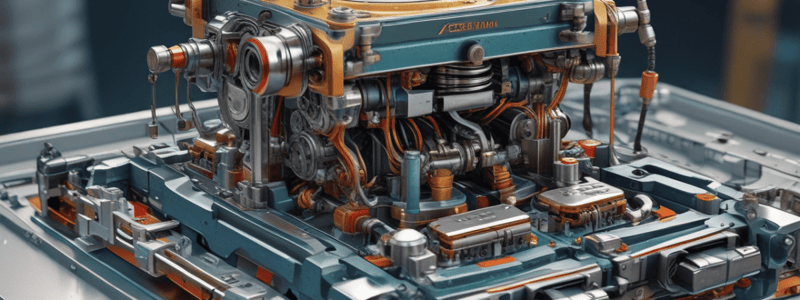Podcast
Questions and Answers
What is the main difference between jigs and fixtures?
What is the main difference between jigs and fixtures?
- Jigs guide the cutting tool, while fixtures may have a means of setting the cutting tool. (correct)
- Jigs are mobile devices, while fixtures are stationary.
- Jigs provide workpiece location, while fixtures provide workpiece clamping.
- Jigs are used in milling operations, while fixtures are used in drilling operations.
Which machining operation typically uses jigs?
Which machining operation typically uses jigs?
- Grinding
- Turning
- Milling
- Drilling (correct)
What is the purpose of a fixture in a machining operation?
What is the purpose of a fixture in a machining operation?
- To provide workpiece confinement
- To guide the cutting tool
- To move freely in multiple planes
- To locate and clamp a workpiece (correct)
What is a likely characteristic of a drill jig?
What is a likely characteristic of a drill jig?
Where are milling fixtures often clamped in a machining setup?
Where are milling fixtures often clamped in a machining setup?
Why is simple confinement of a workpiece not enough for proper location?
Why is simple confinement of a workpiece not enough for proper location?
What is the main purpose of clamping in the context provided?
What is the main purpose of clamping in the context provided?
In clamping considerations, why is it important to direct clamping pressure to supported and/or rigid positions of the work?
In clamping considerations, why is it important to direct clamping pressure to supported and/or rigid positions of the work?
Why should a clamp maintain a force according to the principles of clamping?
Why should a clamp maintain a force according to the principles of clamping?
What should the position of clamps strongly influence according to the context?
What should the position of clamps strongly influence according to the context?
Why is it necessary for a clamping force to be directed through supported or rigid positions?
Why is it necessary for a clamping force to be directed through supported or rigid positions?
Which area should the force F3 be within for stability according to the text?
Which area should the force F3 be within for stability according to the text?
What is the consequence if one pad wears out or a piece of grit is left on a pad?
What is the consequence if one pad wears out or a piece of grit is left on a pad?
Why should a rough surface only be located on a three-point location?
Why should a rough surface only be located on a three-point location?
What happens when a rough surface is brought against a continuous surface?
What happens when a rough surface is brought against a continuous surface?
Why should a relieved location be used for positioning a part?
Why should a relieved location be used for positioning a part?
What were the key achievements related to the world's most accurate space optics as mentioned in the text?
What were the key achievements related to the world's most accurate space optics as mentioned in the text?
What should design always consider when dealing with swarf during machining?
What should design always consider when dealing with swarf during machining?
What is the purpose of a 4 Jaw chuck in workpiece location?
What is the purpose of a 4 Jaw chuck in workpiece location?
Which type of chuck is suitable for circular or triangular work shapes?
Which type of chuck is suitable for circular or triangular work shapes?
What issue arises from redundant location in workpiece fixing?
What issue arises from redundant location in workpiece fixing?
Why should redundant location be avoided in workpiece design?
Why should redundant location be avoided in workpiece design?
In the context of workpiece location, what is the purpose of a 'Diamond Pin Locator'?
In the context of workpiece location, what is the purpose of a 'Diamond Pin Locator'?
What should be the relationship between the width of a locator and the diameter of a location hole?
What should be the relationship between the width of a locator and the diameter of a location hole?
What is the 3-2-1 Principle of Location?
What is the 3-2-1 Principle of Location?
How many degrees of freedom are eliminated by points 1, 2, and 3 in the 3-2-1 Principle of Location?
How many degrees of freedom are eliminated by points 1, 2, and 3 in the 3-2-1 Principle of Location?
What surface condition should be considered when choosing the best form of location for a workpiece?
What surface condition should be considered when choosing the best form of location for a workpiece?
In what situation may a finished surface be located against a fully contacting surface rather than locating points?
In what situation may a finished surface be located against a fully contacting surface rather than locating points?
Why might locating surfaces on four points rather than three introduce new difficulties?
Why might locating surfaces on four points rather than three introduce new difficulties?
Flashcards are hidden until you start studying
Study Notes
- Jigs and fixtures are used as locating and clamping devices during machining operations, with jigs mainly used in drilling and fixtures in milling, turning, and grinding.
- A drill jig includes means of locating and clamping a workpiece and guiding the cutting tool, while a fixture includes means of setting the cutting tool before the cutting process.
- Principles of clamping involve directing force to secure the workpiece against disturbing forces, maintaining workpiece location, and minimizing hazards to operator, workpiece, and cutting tool.
- The position of clamps is influenced by the location points of the workpiece, with considerations for avoiding unopposed moments and ensuring stability.
- Redundant location in fixtures should be avoided to prevent constraints on workpiece movement, with examples such as using diamond pin locators to prevent such issues.
- The 3-2-1 Principle of Location involves holding a part against three points in a base plane, two points in a vertical plane, and one point in a plane square with the first two to fully locate the part.
- Surface condition considerations for locating surfaces include finished surfaces, semi-finished surfaces subject to deviations, and rough surfaces with wide variations.
Studying That Suits You
Use AI to generate personalized quizzes and flashcards to suit your learning preferences.



